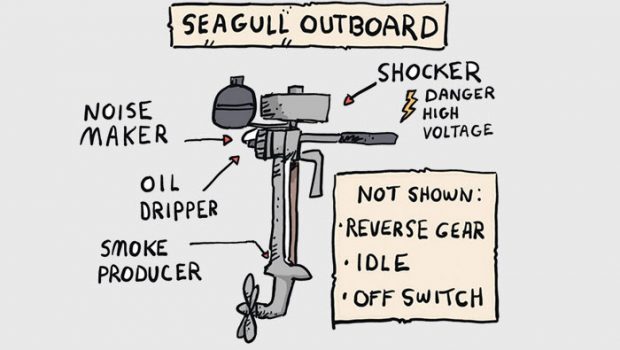Surviving the Seagull outboard era
Published on April 11th, 2022
You have to be of a certain age to have endured the British Seagull outboard engine, and with that perhaps comes an appreciation for everything that followed. Loved by some, hated by many, Donald Street shares a story about this classic creation:
When my son Richard instructed, “I would like to be buried at sea, proper fashion, sewn up in canvas, last stitch through the nose, weighted down by 40 pounds of lead,” I told him how I would not waste 40 pounds of good lead but instead would sink him with one of those darn Seagulls.
However, this noisy polluter did have some virtues.
I remember when anchored off Reaseu Dominica, a crewmember was passing the Seagull from the dinghy to a person on deck and inadvertently dropped the Seagull overboard. We were anchored in about 60 feet of water, and I quickly grabbed the lead line and luckily had on board a coil of 1/8 ” flag halyard.
I dropped the lead line over side and gave it plenty of slack with a long length of flag halyard attached to it so that even if our boat swung, the line would lead to the outboard.
I could see nearby there was some fishing nearby with a big net and two divers with lungs herding fish into the net. So I enlisted their services to connect the line to the engine, and for $20 they succeeded, and we pulled it up to get to work.
The fuel line and air vent had been turned off so no water got into the tank, but the tank was only half full and water pressure had half collapses the tank.
We put the Seagull on its stern pulpit bracket, disconnected the fuel line and carburetor to rinse out in petrol, and then reconnected them. Next was pulling the flywheel to spray the magneto heavily with WD-40, and then put the cap on the flywheel, opened up the fuel line, took a look at the carburetor until fuel came out of the overflow hole.
It was time to test, so I wrapped the starting line around the flywheel and gave a yank with the starting cord. On the fourth yank it started up, but while it ran it would not rev up.
As it was running, we discovered a leak in the head gasket, which prompted us to take the outboard off the pulpit and remove the cylinder head. Using a cardboard file folder, I made a new gasket, re-bolted the cylinder head back in place, and remounted the Seagull on the pulpit bracket.
On about the fifth or sixth pull, it started and ran fine on the file folder gasket. While not wholly beloved, the rugged simplicity and reliability of this menace was a far cry from what you have to do to revive a modern drowned outboard.









 We’ll keep your information safe.
We’ll keep your information safe.